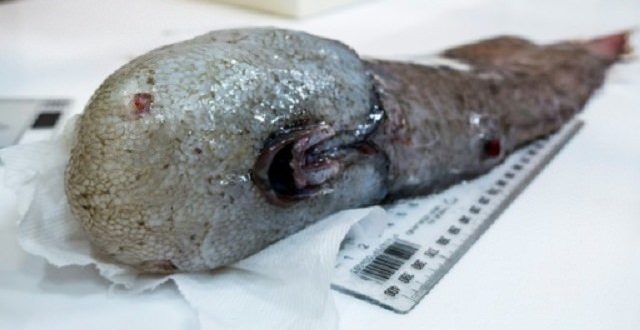This creepy ‘faceless fish’ species was just discovered in the depths of the ocean.
The CSIRO and Museums Victoria scientists discovered the 40cm-long fish, which appears to have no eyes, during a trawl 4000m below sea level in waters south of Sydney.
Other creatures including bright red spiky rock crabs, spectacular bioluminescent sea stars, and gigantic sea spiders as big as a dinner plate have also been collected – along with lumps of coal, PVC pipes and paint tins – during the scientific voyage which began on May 15.
The scientists are taking part in a world-first study of the abyss in an attempt to understand more about what lurks deep beneath Australian waters.
Chief scientist and voyage leader Dr Tim O’Hara, a senior curator of marine invertebrates at Museums Victoria, says it’s the first time the faceless fish has been seen in waters off Australia’s coast since one was picked up by a British ship near Papua New Guinea in 1873.
Dr O’Hara, speaking on board the ship, told the Guardian: “This little fish looks amazing because the mouth is actually situated at the bottom of the animal so, when you look side-on, you can’t see any eyes, you can’t see any nose or gills or mouth.
On board for the month-long voyage along Australia’s east coast are 27 scientists, 13 technicians and 20 crew.
Each day a metal sled-style device attached to eight kilometres of thick wire is carefully lowered to the bottom of the abyss to collect samples of animals and sediment.
A video camera, also attached to wire, trails behind the ship to record what lurks in the murky depths where temperatures are a chilly 1C.
The faceless fish is just one of many specimens that has amazed scientists.
“The experts tell me that about a third of all specimens coming on board are new totally new to science,” Dr O’Hara said.
“They aren’t all as spectacular as the faceless fish, but there’s a lot of sea fleas and worms and crabs and other things that are totally new and no one has seen them ever before.”
But there’s also plenty of disturbing specimens being unearthed.
“There’s a lot of debris, even from the old steam ship days when coal was tossed over board,” Dr O’Hara said.
“We’ve seen PVC pipes and we’ve trawled up cans of paints.
“It’s quite amazing. We’re in the middle of nowhere and still the sea floor has 200 years of rubbish on it.”
The scientists are due to wrap up their research voyage on June 16.
Agencies/Canadajournal
 Canada Journal – News of the World Articles and videos to bring you the biggest Canadian news stories from across the country every day
Canada Journal – News of the World Articles and videos to bring you the biggest Canadian news stories from across the country every day



